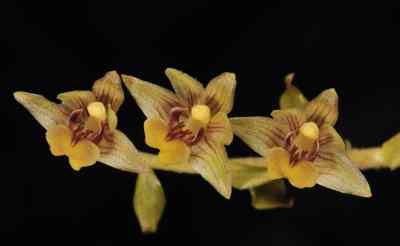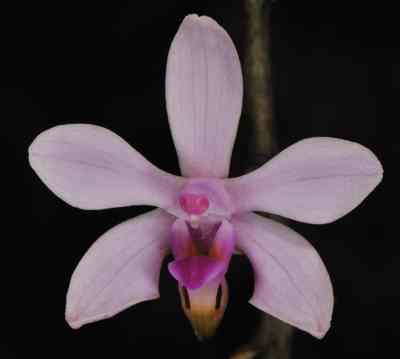Epiphyte. Pseudo-stem 3 or 4 arise from one point, clavate shaped, ribbed from base to apex, with several large sheaths. Leaves from the apex, 3 to 5 in number, oblong-lanceolate, tapering to the base, 5 to 8 cm in length and 2 to 3 cm in width. Each stem with 3 to 4 raceme, arising from the axils of each sheath. Flowers many, less than 2 cm across. Sepals and petals brownish yellow with 5 purple veins all through its length. The lateral lobes, disc and lamellae of the lip is purplish red and its apical lobe bright yellow.

The Pursuit
A beautiful species with wide range of habitats in the region. Its peculiar stems are an attraction and can be easily spotted. I had located the species in my earlier days of flower hunt itself. However, I missed it for a couple of seasons and got the opportunity to document it in the year 2012 only. When I visited the plant I marked for documenting, the whole branch of that host tree was full of flowers of this species. Even though the flowers are only 2 cm across, they grow in dense raceme to create a beautiful view. Being a common species, I haven’t put much attention and was casually documenting it with 5 micro flashes. After the shoot, when I was transferring the photographs only I noticed its peculiar lip disc and the well developed lamellae. Then I decided to document those flowers again and to record those details in a better way. With fallen logs and bamboo pieces from the forest floor quickly made an erect structure of about 8 ft high. Tied it to the host tree with local creeper twigs and climbed on to it to create a steady view of the flowers. Selected a few freshly bloomed flowers and with 11 micro flashes and 2 optical fibre cable lightings I produced this wonderful photograph of the species. If anybody ask me to gift the best photograph from my collection, I will surely offer this photograph.








